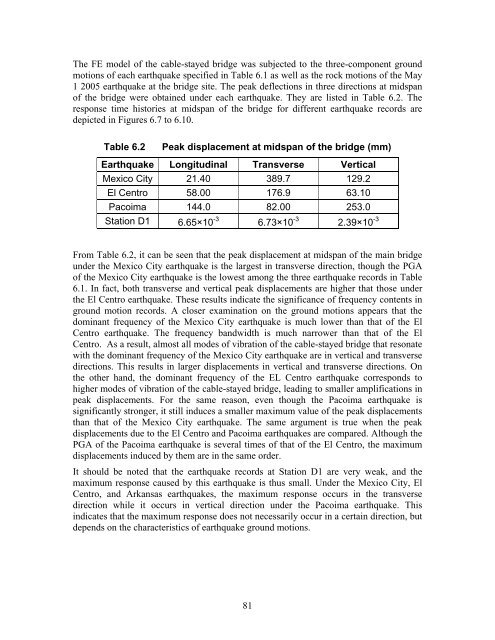Assessment of the Bill Emerson Memorial Bridge - FTP Directory ...
Assessment of the Bill Emerson Memorial Bridge - FTP Directory ...
Assessment of the Bill Emerson Memorial Bridge - FTP Directory ...
- No tags were found...
Create successful ePaper yourself
Turn your PDF publications into a flip-book with our unique Google optimized e-Paper software.
The FE model <strong>of</strong> <strong>the</strong> cable-stayed bridge was subjected to <strong>the</strong> three-component groundmotions <strong>of</strong> each earthquake specified in Table 6.1 as well as <strong>the</strong> rock motions <strong>of</strong> <strong>the</strong> May1 2005 earthquake at <strong>the</strong> bridge site. The peak deflections in three directions at midspan<strong>of</strong> <strong>the</strong> bridge were obtained under each earthquake. They are listed in Table 6.2. Theresponse time histories at midspan <strong>of</strong> <strong>the</strong> bridge for different earthquake records aredepicted in Figures 6.7 to 6.10.Table 6.2Peak displacement at midspan <strong>of</strong> <strong>the</strong> bridge (mm)Earthquake Longitudinal Transverse VerticalMexico City 21.40 389.7 129.2El Centro 58.00 176.9 63.10Pacoima 144.0 82.00 253.0Station D1-36.65×10-36.73×10-32.39×10From Table 6.2, it can be seen that <strong>the</strong> peak displacement at midspan <strong>of</strong> <strong>the</strong> main bridgeunder <strong>the</strong> Mexico City earthquake is <strong>the</strong> largest in transverse direction, though <strong>the</strong> PGA<strong>of</strong> <strong>the</strong> Mexico City earthquake is <strong>the</strong> lowest among <strong>the</strong> three earthquake records in Table6.1. In fact, both transverse and vertical peak displacements are higher that those under<strong>the</strong> El Centro earthquake. These results indicate <strong>the</strong> significance <strong>of</strong> frequency contents inground motion records. A closer examination on <strong>the</strong> ground motions appears that <strong>the</strong>dominant frequency <strong>of</strong> <strong>the</strong> Mexico City earthquake is much lower than that <strong>of</strong> <strong>the</strong> ElCentro earthquake. The frequency bandwidth is much narrower than that <strong>of</strong> <strong>the</strong> ElCentro. As a result, almost all modes <strong>of</strong> vibration <strong>of</strong> <strong>the</strong> cable-stayed bridge that resonatewith <strong>the</strong> dominant frequency <strong>of</strong> <strong>the</strong> Mexico City earthquake are in vertical and transversedirections. This results in larger displacements in vertical and transverse directions. On<strong>the</strong> o<strong>the</strong>r hand, <strong>the</strong> dominant frequency <strong>of</strong> <strong>the</strong> EL Centro earthquake corresponds tohigher modes <strong>of</strong> vibration <strong>of</strong> <strong>the</strong> cable-stayed bridge, leading to smaller amplifications inpeak displacements. For <strong>the</strong> same reason, even though <strong>the</strong> Pacoima earthquake issignificantly stronger, it still induces a smaller maximum value <strong>of</strong> <strong>the</strong> peak displacementsthan that <strong>of</strong> <strong>the</strong> Mexico City earthquake. The same argument is true when <strong>the</strong> peakdisplacements due to <strong>the</strong> El Centro and Pacoima earthquakes are compared. Although <strong>the</strong>PGA <strong>of</strong> <strong>the</strong> Pacoima earthquake is several times <strong>of</strong> that <strong>of</strong> <strong>the</strong> El Centro, <strong>the</strong> maximumdisplacements induced by <strong>the</strong>m are in <strong>the</strong> same order.It should be noted that <strong>the</strong> earthquake records at Station D1 are very weak, and <strong>the</strong>maximum response caused by this earthquake is thus small. Under <strong>the</strong> Mexico City, ElCentro, and Arkansas earthquakes, <strong>the</strong> maximum response occurs in <strong>the</strong> transversedirection while it occurs in vertical direction under <strong>the</strong> Pacoima earthquake. Thisindicates that <strong>the</strong> maximum response does not necessarily occur in a certain direction, butdepends on <strong>the</strong> characteristics <strong>of</strong> earthquake ground motions.81
















